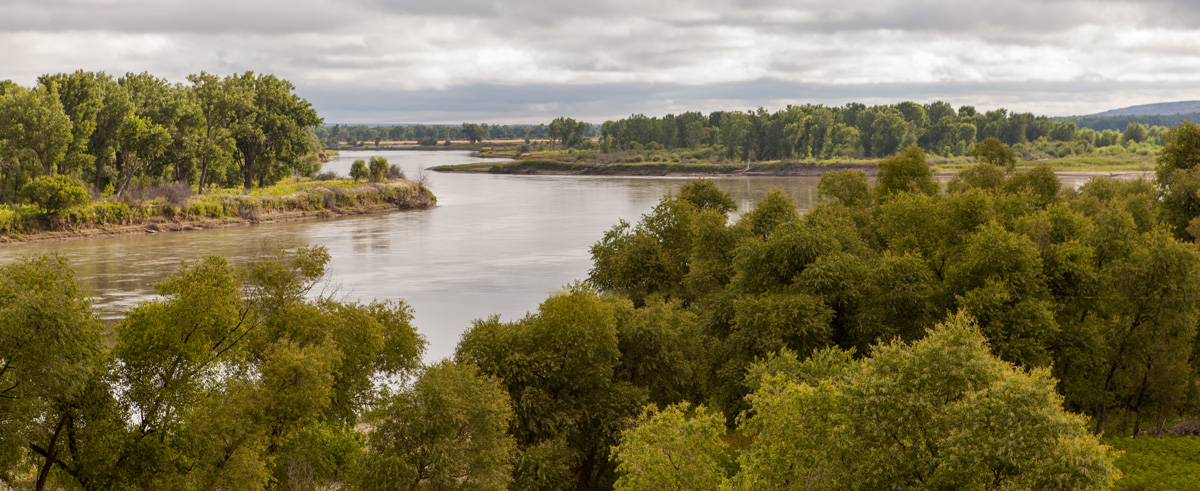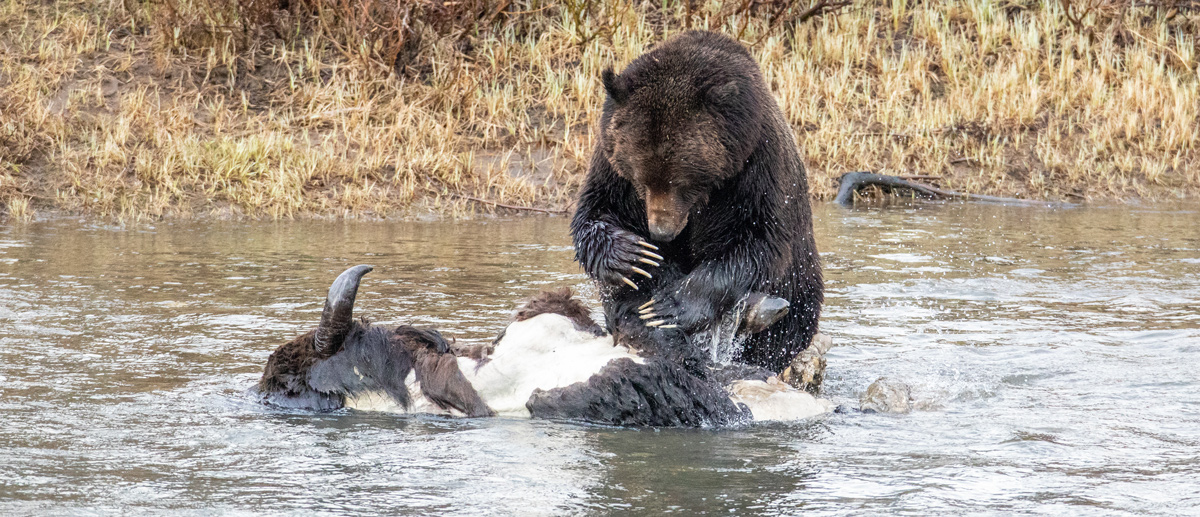On or near this date, Sgt. Pryor and his small group reach the mouth of the Yellowstone. There, he takes Clark’s note meant for Lewis. That decision would delay the captains’ reunion by several days.
Both Clark’s and Lewis’s groups endure a stormy night. Delayed by winds, Lewis passes the Poplar River and camps near present Brockton, Montana.
Near present Williston, North Dakota, Clark moves down the river a short distance. A grizzly bear mistakes one of their dugouts for a dead bison floating in the river and Clark sees where Indians have been digging breadroot.[1]For more on the captains’ strategy and various groups after leaving Travelers’ Rest, see Dividing Forces at Travelers’ Rest.
Missouri River Morning
Below Poplar, Montana, 26 July 2013. © by Kristopher K. Townsend. Permission to use granted under the Creative Commons Attribution-Share Alike 4.0 International license.
Storms and Winds (Lewis)
A Stormy Night
in attending to the canoes I got wet to the skin and having no shelter on land I betook myself to the orning of the perogue which I had, formed of Elkskin, here I obtained a few hours of broken rest; the wind and rain continued almost all night and the air became very cold.
—Meriwether Lewis
Delayed by Winds
we set out early this morning and decended the river about 10 miles below Porcupine river when the wind became so violent that I laid by untill 4 P. M. the wind then abaiting in some measure we again resumed our voyage, and decended the river about 5 miles below our encampment of the 1st of May 1805
—Meriwether Lewis
Easy Hunting
in short game is so abundant and gentle that we kill it when we please. the Feildses went on ahead this evening and we did not overtake them. we saw several bear in the course of the day.—
—Meriwether Lewis
A Wet Night (Clark)
Grizzly Attack
This morning a very large Bear of white Specis, discovered us floating in the water and takeing us, as I prosume to be Buffalow imediately plunged into the river and prosued us . . . . I have observed buffalow floating down which I suppose must have been drounded in Crossing above.
—William Clark
Wet Night and Morning
I rose very wet . . . . as we were about Setting out a female Big horn animal came on the bluff imediately above us and looked down. I derected Labeech [Labiche] to Shoot it which he did, after Skinning this animal . . . .
—William Clark
Indigenous Agriculture
. . . we Set out and proceeded on to a Sand bar on the S W. Side below the enterance of White earth river where I landed and had the meat Skins and bedding all put out to dry. wind hard from the N W. I halted on the N W. Side of this river in the bend above the white earth river, where I saw where the Indians had been digging a root which they eate and use in Seup, not more than 7 or 8 days past.
—William Clark
Mosquitoes Starve the Deer
I derected the men to dress their Skins except one which I took with me and walkd. through the bottom to the foot of the hills I killed five deer and the man with me killed 2. four others were killed in the Course of the day by the party only 2 of those deer were fat owing as I suppose to the Musquetors which are So noumerous and troublesom to them that they Cannot feed except under the torments of millions of those Musquetors.
—William Clark
Pryor Takes Clark’s Note
Mouth of the Yellowstone
they [Pryor, et al.] informed us that the distance from where they Struck the River Roshjone to its mouth is 836 miles and a pleasant river bottoms and timber on this river
—William Clark (recorded 8 August 1806)[2]Precise dates and locations for Pryor’s trip down the Yellowstone are not known. Pryor was instructed to keep a journal, but it if he did, it is lost.
Taking Clark’s Note
The note I left on a pole at the Mouth of the River Rochejhone Sergt. Pryor concluding that Capt. Lewis had passed took the note and brought it with him. Capt Lewis I except will be certain of my passing by the Sign which I have made and the encampment imediately in the point.
—William Clark (recorded 8 August 1806)
Weather Diaries
State of the weather at rise
Wind at rise
State of the weather at 4 P. M. Wind at 4 P. M. fair after rain thunder & lightning N. E. fair N. E. a violent gust of Thunder Lightning wind and hail last night.
—Meriwether Lewis
State of the weather at Sun rise State of wind at Sunrise State of the weather at 4 P. M. Wind at 4 P. M. State of river cloudy after rain thunder & lightning S W. fair N E fall 2 ½ in. rained hard last night with Thunder Lightning & hard wind from S. W. killed a white Bear [grizzly bear] & Bighorn [sheep].
—William Clark[3]To assist the reader of this web page, the date column is not presented, some abbreviations have been spelled out, and the three river columns have been merged.
Notes
| ↑1 | For more on the captains’ strategy and various groups after leaving Travelers’ Rest, see Dividing Forces at Travelers’ Rest. |
|---|---|
| ↑2 | Precise dates and locations for Pryor’s trip down the Yellowstone are not known. Pryor was instructed to keep a journal, but it if he did, it is lost. |
| ↑3 | To assist the reader of this web page, the date column is not presented, some abbreviations have been spelled out, and the three river columns have been merged. |
Experience the Lewis and Clark Trail
The Lewis and Clark Trail Experience—our sister site at lewisandclark.travel—connects the world to people and places on the Lewis and Clark Trail.
Discover More
- The Lewis and Clark Expedition: Day by Day by Gary E. Moulton (University of Nebraska Press, 2018). The story in prose, 14 May 1804–23 September 1806.
- The Lewis and Clark Journals: An American Epic of Discovery (abridged) by Gary E. Moulton (University of Nebraska Press, 2003). Selected journal excerpts, 14 May 1804–23 September 1806.
- The Lewis and Clark Journals. by Gary E. Moulton (University of Nebraska Press, 1983–2001). The complete story in 13 volumes.



